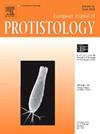环境元条形码揭示的卡塔尔旱地原生生物多样性。
IF 1.6
2区 生物学
Q4 MICROBIOLOGY
引用次数: 0
摘要
我们调查了五个地点的土壤原生生物群落,代表了卡塔尔两种典型的旱地栖息地:rawdha和sabkha。在一次实地活动中总共收集了100个样本;随后提取DNA,扩增18S rRNA基因的V4区。我们获得了112529个高质量序列,在分类上代表1524个TSAR (Telonemia, Stramenopila, Alveolata, Rhizaria)扩增子序列变异。这种方法能够检测到不同的真核生物谱系,并有助于评估它们的多样性和相对丰度。原生生物多样性在不同生境和不同样品间差异显著,丰富度在不同生境间差异显著。在所有样本中,鉴定出170个属,其中52个属在所有站点共享。Sabkha表现出最多的专属属(22个),几乎是任何单个rawdha遗址的3倍。在大多数样本中,肺泡枝占总属丰富度的50%或更多。在纤毛虫中,取样时最多的是螺旋体纲和阴道纲。功能分析显示,消费者是主要的营养群体。本研究通过独特地比较两种近地陆地栖息地,提高了我们对极端高温环境中微生物生命的理解,尽管气候条件相似,但它们表现出截然不同的土壤和物理化学特征。本文章由计算机程序翻译,如有差异,请以英文原文为准。
Diversity of protists in dryland habitats of Qatar revealed by environmental metabarcoding
We investigated soil protist communities across five sites representing two characteristic dryland habitats in Qatar: rawdha and sabkha. Altogether, 100 samples were collected during a single field campaign; DNA was subsequently extracted, and the V4 region of the 18S rRNA gene was amplified. We obtained 112,529 high-quality sequences, taxonomically representing 1,524 TSAR (Telonemia, Stramenopila, Alveolata, Rhizaria) amplicon sequence variants. This approach enabled detection of diverse eukaryotic lineages and facilitated assessment of their diversity and relative abundance. Protist diversity differed significantly between habitats and among samples, while richness varied significantly between habitats. Across all samples, 170 genera were identified, of which 52 were shared across all sites. Sabkha exhibited the highest number of exclusive genera (22), nearly three times the number found in any individual rawdha site. The clade Alveolata accounted for 50 % or more of overall genus richness in most samples. Among ciliates, the classes Spirotrichea and Colpodea were the most abundant at the time of sampling. Functional analysis revealed consumers as the dominant trophic group. This study advances our understanding of microbial life in extremely hot environments by uniquely comparing two proximate terrestrial habitats that, despite similar climatic conditions, exhibit distinct edaphic and physicochemical characteristics.
求助全文
通过发布文献求助,成功后即可免费获取论文全文。
去求助
来源期刊

European journal of protistology
生物-微生物学
CiteScore
4.60
自引率
20.70%
发文量
55
审稿时长
14.6 weeks
期刊介绍:
Articles deal with protists, unicellular organisms encountered free-living in various habitats or as parasites or used in basic research or applications. The European Journal of Protistology covers topics such as the structure and systematics of protists, their development, ecology, molecular biology and physiology. Beside publishing original articles the journal offers a forum for announcing scientific meetings. Reviews of recently published books are included as well. With its diversity of topics, the European Journal of Protistology is an essential source of information for every active protistologist and for biologists of various fields.
 求助内容:
求助内容: 应助结果提醒方式:
应助结果提醒方式:


